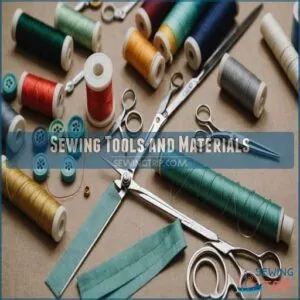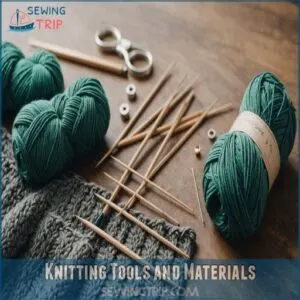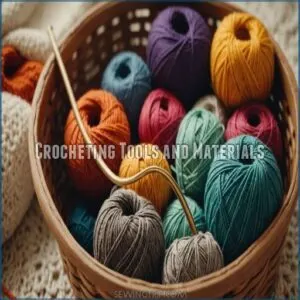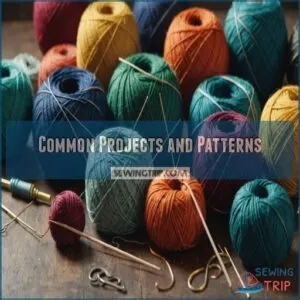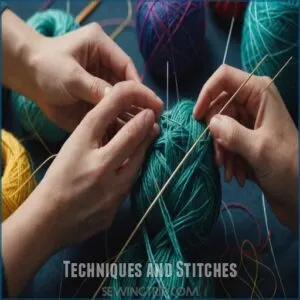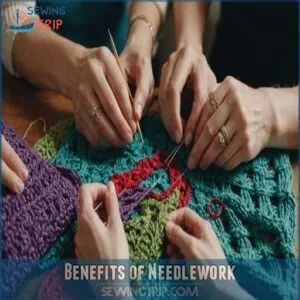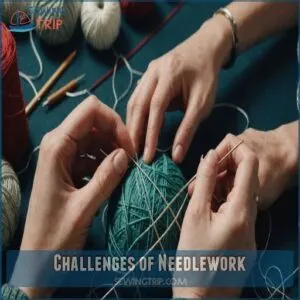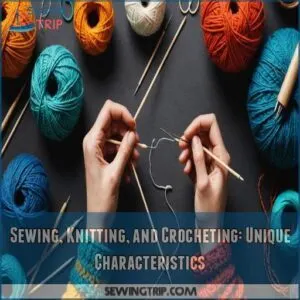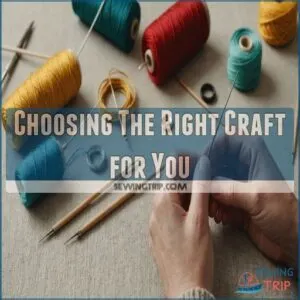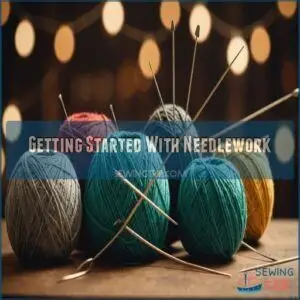This site is supported by our readers. We may earn a commission, at no cost to you, if you purchase through links.
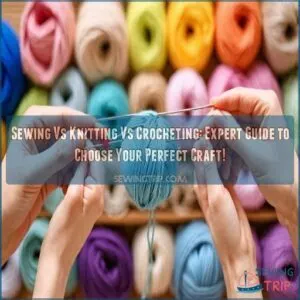
Sewing joins fabric pieces, perfect for creating garments or home decor.
Knitting uses two needles to loop yarn, ideal for cozy sweaters and scarves.
Crocheting, the rebel of the bunch, uses just one hook to create intricate patterns.
You’ll find that each craft offers a different level of precision, flexibility, and creative expression.
Whether you’re mending a torn shirt, whipping up a warm beanie, or crafting delicate doilies, these skills can transform your creative life.
But which one’s right for you? The answer might surprise you as we unravel the secrets of each craft.
Table Of Contents
- Key Takeaways
- Needlework Basics Explained
- Essential Tools and Materials
- Common Projects and Patterns
- Techniques and Stitches
- Benefits of Needlework
- Challenges of Needlework
- Knitting Vs. Crocheting: a Comparison
- Sewing, Knitting, and Crocheting: Unique Characteristics
- Choosing The Right Craft for You
- Getting Started With Needlework
- Frequently Asked Questions (FAQs)
- Conclusion
Key Takeaways
- You’ll find each craft has unique strengths: sewing excels at joining fabrics, knitting creates stretchy textiles, and crocheting offers intricate patterns.
- Your choice depends on your goals: sewing is ideal for garments and home decor, which can also be made from repurposed materials by learning how to recycle sewing scraps, knitting shines for cozy wearables, and crocheting is perfect for accessories and quick projects.
- You’ll experience different learning curves: crocheting is often easier to start, knitting can be more complex, and sewing requires understanding fabric properties.
- You’ll gain more than just a hobby: all three crafts offer stress relief, improve dexterity, and provide opportunities for creative expression and community building.
Needlework Basics Explained
You’re about to explore three amazing crafts that’ll transform simple threads and fabrics into beautiful creations with just your hands and a few tools.
Whether you’re interested in joining pieces of fabric with a needle and thread, creating fabric from yarn with two needles, or working yarn into patterns with a single hook,
you’ll find your perfect match in sewing, knitting, or crocheting.
Definition of Sewing
Three simple tools – a needle, thread, and fabric – open up a world of creative possibilities through sewing.
You’ll join pieces of fabric together by passing thread through them, following techniques like selecting fabric by type, to create garments, home décor, or repairs.
Here’s what makes sewing unique:
- It’s the oldest form of textile art
- You can create custom-fitted clothing
- It’s perfect for both practical repairs and artistic expression
- You’ll master various stitches for different effects
Definition of Knitting
You’ll find knitting to be a mesmerizing dance of two needles, where you’ll loop and interlock yarn into gorgeous fabric one stitch at a time.
To create your desired project, you can find a wide selection of knitting yarn at stores like Those Yarn Stores.
Using various stitch patterns and yarn types, you’ll create anything from cozy sweaters to delicate shawls.
Think of it as building with yarn – each row of stitches builds upon the last, while maintaining proper tension helps control your fabric’s gauge.
Definition of Crocheting
Crocheting takes yarn crafting to a whole new level.
With just a single hook and some yarn, you’re weaving magic!
It’s like knitting’s free-spirited cousin, allowing you to create intricate patterns and textures.
Here’s what crocheting looks like in action:
- Your hands dance, looping yarn around the hook
- Stitches build up, row by row, forming fabric
- Suddenly, a cozy blanket or cute amigurumi emerges
Crochet hooks and yarns are your tools for endless creativity.
Brief History of Each Craft
Needle and thread have woven through time, shaping our cultural fabric.
Sewing traces back to the Paleolithic era, with bone needles found in Ice Age sites.
Knitting emerged in Egypt around 1000 CE, spreading globally.
Crochet, the youngest of the trio, gained popularity in 19th-century Europe.
Each craft evolved, impacting fashion, economy, and social norms across cultures.
Essential Tools and Materials
You’ll need the right gear to start your needlework journey, and each craft has its own unique toolkit.
From needles and thread for sewing to yarn and hooks for crocheting, we’ll explore the essential tools and materials that’ll set you up for success in your chosen craft.
Sewing Tools and Materials
Crafting your perfect sewing kit is like assembling a toolbox for creativity.
To get started, you’ll need:
- When choosing a sewing machine, consider the best and worst sewing machine brands, such as top-rated options like Bernina and Singer, which offer quality and innovation, as seen in reliable sewing machine brands. A reliable sewing machine (mechanical or computerized)
- Sharp scissors and pins for fabric prep
- An assortment of needles and thread types
Don’t forget measuring tools, seam rippers, and a variety of fabrics.
With these essentials, you’re ready to tackle any project, from simple repairs to intricate designs. Remember, quality tools make for smoother sailing in your sewing adventures!
Knitting Tools and Materials
While sewing machines hum, knitting tools whisper.
You’ll need a pair of knitting needles – straight, circular, or double-pointed – to get started.
Yarn is your canvas; choose from wool, cotton, or synthetic blends.
Don’t forget stitch markers, a tapestry needle, and scissors.
For bigger projects, invest in a row counter and cable needles.
Remember, gauge swatches are your best friends for perfect project sizing!
Crocheting Tools and Materials
From needles to hooks, you’re in for a treat!
Crocheting’s toolbox is simpler than knitting’s, but just as magical.
To make sure you have a smooth start, match your hook size to the yarn weight guide.
You’ll need a crochet hook (sizes matter!), yarn (oh, the choices!), and a pair of scissors.
Don’t forget stitch markers and a tapestry needle for finishing touches.
A project bag keeps everything tidy.
Ready to hook your way to crafting bliss?
Common Projects and Patterns
You’ll find a world of creative possibilities in sewing, knitting, and crocheting projects, from simple scarves to intricate quilts.
Whether you’re a beginner or an expert, there’s always a new pattern to try that’ll challenge your skills and spark your imagination.
Sewing Projects for Beginners
Ready to get started with sewing? You’ll love these beginner-friendly projects that’ll have you stitching like a pro in no time.
Start with simple, fun items that boost your confidence and teach you essential skills.
Here are three easy sewing projects to kick off your crafting journey:
- Tote bag: Perfect for groceries or beach trips
- Pillowcase: Spruce up your bedroom decor
- Drawstring pouch: Great for organizing small items
These projects let you practice basic stitches, fabric choices, and sewing machine basics while creating useful items.
Knitting Projects for Beginners
Got your needles ready? Let’s jump into beginner-friendly knitting projects!
To begin with sewing, mastering basic stitches is essential, and you can learn how to easy sew by practicing techniques like straight stitches, which involve poking the needle into the fabric and adjusting stitch length, as seen in sewing techniques tutorials. Start with easy knit scarves – they’re perfect for mastering basic stitches.
Move on to simple hats, great for learning shaping techniques.
For a cozy winter accessory, try knitting mittens tutorials using worsted weight yarn and the magic loop technique.
Explore free knitting patterns online for inspiration.
Remember, choosing the right yarn weight is important.
Start with chunky yarns for quicker results.
With these project planning tips, you’ll be knitting up a storm in no time!
Crocheting Projects for Beginners
Your crocheting journey starts with simple, rewarding projects that’ll have you hooked in no time.
Before starting your crochet or knitting project, it’s essential to master basic hand stitches like running, back, and slip stitch by hand, which are also useful for sewing techniques basics. Begin with easy crochet squares to master basic stitches, then level up to beginner scarves that’ll keep you cozy.
As you gain confidence, explore crochet amigurumi or tackle simple crochet blankets.
With free crochet patterns at your fingertips, you’ll be crafting like a pro before you know it.
- A colorful granny square pillow that brightens up your living room
- A chunky infinity scarf that’s perfect for chilly autumn days
- An adorable amigurumi teddy bear, ready to become someone’s new best friend
Advanced Projects for Each Craft
Once you’ve mastered the basics, it’s time to tackle advanced projects.
In sewing, try your hand at custom suits or intricate wedding gowns.
Knitters can challenge themselves with Fair Isle sweaters or lace shawls.
Crocheters might dive into freeform sculpture or complex afghan designs.
These large-scale projects showcase unique textures and creative embellishments, allowing you to flex your fiber arts muscles and create truly impressive pieces.
Techniques and Stitches
You’ll find a variety of stitches and techniques in sewing, knitting, and crocheting, each with its own unique charm.
From basic running stitches to intricate cable knits, these crafts offer endless possibilities to create beautiful and functional items.
Basic Sewing Stitches
While mastering sewing machine basics is important, hand stitching techniques are the backbone of any seamstress’s toolkit.
You’ll want to get comfortable with these essential stitches:
- Running stitch: The simplest stitch, perfect for basting and gathering
- Backstitch: A sturdy stitch for seams that need strength
- Whipstitch: Ideal for finishing edges and attaching appliques
These stitches are your ticket to textile crafting freedom.
With practice, you’ll be whipping up buttonholes and seam finishes like a pro in no time.
Basic Knitting Stitches
Now let’s explore the world of knitting!
The knit stitch is your foundation, creating those classic V-shaped loops.
You’ll soon master purling, the yin to knitting’s yang.
Ready for a challenge? Try cable stitches for eye-catching textures.
Double knitting opens doors to reversible patterns, while colorwork lets you paint with yarn.
With each stitch, you’re weaving a tapestry of skills and creativity.
Basic Crocheting Stitches
Ready to get started with basic crocheting stitches?
You’ll start with the slip stitch, then move on to single crochet.
As you progress, you’ll tackle half double crochet, double crochet, and treble crochet.
Each stitch builds on the last, boosting your skills.
Crocheting offers:
- A sense of accomplishment with each completed row
- Stress relief through repetitive, meditative motions
- Endless creative possibilities as you mix and match stitches
Master these basics, and you’ll be hooked on crochet in no time!
Advanced Techniques for Each Craft
Looking to level up your craft? Let’s explore some advanced techniques.
In sewing, you’ll master appliqué and embroidery, adding flair to your projects.
Knitting enthusiasts can tackle intarsia and Fair Isle for stunning colorwork.
Crocheters, try your hand at freeform and colorwork crochet for unique textures.
These skills open doors to garment making and quilting, letting you create one-of-a-kind pieces.
Remember, practice makes perfect, so don’t get discouraged!
Benefits of Needlework
You’ll love how needlework can improve your life in surprising ways.
From calming your mind to boosting your creativity, these crafts offer a world of benefits that go far beyond just making pretty things.
Relaxation and Stress Relief
Mastering stitches opens the door to a world of relaxation.
As you settle into your needlework rhythm, you’ll feel tension melt away.
The repetitive motions of sewing, knitting, or crocheting act as a form of mindfulness, focusing your attention on the present.
Your breathing slows, and you become more aware of your body.
This sensory focus creates a soothing flow state, offering a much-needed break from daily stress.
Creative Expression and Personalization
Needlework lets your inner artist shine, letting you create one-of-a-kind pieces that reflect your style.
You’re not just following patterns; you’re putting your personal stamp on every stitch.
With endless possibilities for customization, your projects become extensions of your creativity.
Here’s how you can make your work truly unique:
- Mix and match colors for eye-catching designs
- Add embellishments like beads or embroidery for extra flair
- Experiment with different textures and yarn weights
- Modify patterns to suit your taste or create entirely new ones
Social Benefits and Community Building
Your creative stitches aren’t just for you – they’re a ticket to a vibrant community!
Join needlework groups or online forums to share tips and show off your latest projects.
Craft fairs and workshops let you mingle with like-minded folks, swapping ideas over shared projects.
It’s not just about the craft; it’s about the connections you’ll knit together along the way.
Cognitive Benefits and Improved Dexterity
While you’re stitching up a storm with friends, your brain’s getting a workout too, and the repetitive motions can even have a therapeutic effect, similar to how sewing calms anxiety.
Knitting or crocheting sharpens your focus and boosts memory.
It’s like CrossFit for your fingers, improving dexterity and hand-eye coordination.
Tackling tricky patterns? That’s problem-solving in action.
You’re not just creating cozy blankets; you’re building a sharper mind.
So pick up those needles – your brain will thank you!
Challenges of Needlework
You’ll face some hurdles as you start your needlework journey, from learning new skills to finding time for projects.
These challenges, like mastering techniques and budgeting for supplies, are part of the craft’s growth process, but don’t worry—they’re all manageable with patience and practice.
Learning Curve and Frustration
At first, you’ll feel like you’re all thumbs.
Tangled threads, dropped stitches, and wonky seams are par for the course.
Don’t let these beginner mistakes get you down – learning sewing basics like hand sewing vs machine sewing will really help.
Everyone faces common frustrations when starting out.
The key to overcoming challenges? Patience and practice.
Take it one stitch at a time, find reliable resources, and remember: even experts were once beginners.
You’ve got this!
Time Commitment and Project Completion
Juggling needlework projects with daily life can feel like herding cats.
You’ll find project timelines vary wildly – a quick scarf might take a weekend, while an intricate quilt could span months.
Your completion rates depend on your skill level and available time.
Mastering time management is key; start small to build confidence.
Remember, it’s a marathon, not a sprint.
Embrace the learning curve and enjoy the journey!
Cost of Materials and Equipment
The cost of materials and equipment can be a real eye-opener in needlework.
You’ll need to invest in starter kit essentials, but don’t let that scare you off.
Compare project costs across crafts to find budget-friendly alternatives.
Scout for material sourcing tips online or at local craft stores.
Remember, quality tools are a long-term investment that’ll save you money and frustration down the road.
Physical Demands and Health Considerations
Your needle-wielding passion can be a double-edged sword for your health.
While crafting brings joy, it’s important to mind your body.
To start sewing or upgrade your current setup, investing in a reliable sewing machine tool can make all the difference in your crafting journey.
Here are four key considerations:
- Ergonomics: Set up your workspace to support good posture
- Hand pain: Take breaks to avoid repetitive strain injuries
- Eye strain: Use proper lighting to reduce visual fatigue
- Posture: Alternate positions to prevent muscle stiffness
Remember, a stitch in time saves nine – especially when it comes to self-care!
Knitting Vs. Crocheting: a Comparison
You’ve got your needles ready, but which craft should you choose? Let’s compare knitting and crocheting to help you find your perfect match.
Similarities and Differences
Now that we’ve tackled the hurdles, let’s compare knitting and crocheting.
These crafts may seem like two peas in a pod, but they’ve got their own unique flavors.
Check out this quick comparison:
| Feature | Knitting | Crocheting |
|---|---|---|
| Tools | Two needles | One hook |
| Stitches | Loops on needles | Interlocking loops |
| Fabric | Stretchy, thin | Sturdy, thick |
Both crafts offer endless creative possibilities, but they shine in different ways.
Your choice might depend on your project goals and personal style.
Ease of Learning and Beginner-Friendliness
In terms of first-stitch success, both knitting and crocheting have their unique learning curves.
Crocheters often find it easier to get started, using just one hook and mastering a few basic stitches.
Knitters, however, juggle two needles but benefit from a wealth of resources.
Here’s a quick breakdown:
- Crochet: Simpler tool manipulation, faster skill progression
- Knitting: More intricate techniques, wider project selection
- Both: Abundant tutorials and supportive communities for beginners
Speed and Efficiency of Each Craft
Speed can make or break your crafting experience.
Let’s get into the nitty-gritty of knitting versus crocheting efficiency:
| Factor | Knitting | Crocheting |
|---|---|---|
| Time per stitch | Slower | Faster |
| Stitch density | Higher | Lower |
| Project complexity | Varies | Varies |
| Yarn weight impact | Significant | Moderate |
Crocheting often outpaces knitting, especially for beginners.
But don’t let that fool you!
Project complexity and your personal rhythm play huge roles.
Remember, it’s not a race—find your flow and enjoy the journey.
Sewing, Knitting, and Crocheting: Unique Characteristics
You’re about to explore the unique characteristics of sewing, knitting, and crocheting – three crafts that each offer their own special magic.
These time-honored techniques have distinct histories, uses, and benefits that you’ll soon discover, helping you find your perfect match in needlework.
Sewing: History, Uses, and Benefits
Humanity’s needle and thread have woven a rich tapestry of sewing history.
From ancient civilizations to modern fashion, sewing has shaped textile and clothing evolution.
You’ll find it’s more than just mending holes – it’s a gateway to creativity and practicality.
With basic sewing tools, you can customize clothes, create home decor, and even save money.
Plus, the focus required can be wonderfully meditative, offering both mental and financial benefits.
Knitting: History, Uses, and Benefits
Knitting’s rich history spans centuries, weaving its way through cultures worldwide.
You’ll find it’s not just about creating cozy sweaters anymore.
From ancient Egyptian socks to modern art installations, knitting’s versatility shines.
Here’s a quick rundown of knitting’s perks:
- Stress relief: Rhythmic motions calm your mind
- Portable creativity: Craft on-the-go
- Customizable fashion: Design your own wearables
- Brain booster: Enhance cognitive function
With various yarn types and patterns, you’re in control of your knitting journey.
Crocheting: History, Uses, and Benefits
While knitting has its charms, crocheting offers its own unique flair.
This craft’s history dates back centuries, with hooks creating intricate lace and sturdy fabrics.
Today, you’ll find crocheters whipping up everything from cozy blankets to trendy accessories.
The benefits? It’s portable, versatile, and often quicker than knitting.
Plus, the crochet community is warm and welcoming – you’ll find friends and inspiration in no time!
Choosing The Right Craft for You
You’ve got options in needlework, and picking the right craft is key to your crafting success.
Think about what you want to make, how much time you can spare, and which techniques appeal to you most as you choose between sewing, knitting, and crocheting.
Personal Preferences and Goals
Now that you’re familiar with each craft’s unique traits, let’s focus on you.
Your personal preferences and goals are key in choosing the right craft.
Do you crave quick results or enjoy lengthy projects?
Consider your time commitment and desired outcome.
Are you drawn to intricate designs or simpler patterns?
Think about project complexity and your learning style.
Your perfect craft should align with your lifestyle and creative aspirations.
Skill Level and Experience
Your skill level and experience play a key role in choosing your craft.
Sewing’s straightforward nature makes it ideal for beginners, while knitting and crocheting have steeper learning curves.
Consider your patience for mastering techniques and time commitment.
For instance, sewing allows you to start with beginner-friendly projects, like making your own clothes with simple patterns and fabrics.
For a smooth start in sewing, master essential tools like a seam ripper tool, then start with simple projects to avoid common beginners’ mistakes.
Explore learning resources like tutorials and classes to build your skills.
Remember, each craft offers unique challenges and rewards as you progress.
Project Type and Desired Outcome
Let’s zero in on your project dreams.
For home decor like curtains or quilts, sewing’s your go-to.
Knitting shines for cozy sweaters and scarves, while crocheting’s perfect for unique accessories and toys.
Want to whip up quick gifts? Crochet’s your friend.
Each craft has its sweet spot, so match your project goals with the right technique. You’ll be crafting like a pro in no time!
Getting Started With Needlework
You’re ready to start your needlework journey, but where to begin?
Whether you’re picking up a needle and thread, knitting needles, or a crochet hook, remember that everyone starts as a beginner, and with practice, you’ll soon be crafting like a pro.
Tips for Beginners
Ready to start needlework? Here are some practical tips to get you started:
- Start small: Choose simple projects to build confidence.
- Practice regularly: Consistency is key to improving your skills.
- Be patient: Rome wasn’t built in a day, and neither is perfect needlework.
When choosing yarn, consider the project’s needs.
Plan your project carefully, paying attention to stitch tension and needle size.
Remember, everyone starts somewhere – embrace the learning process and enjoy the journey!
Joining a Community or Finding a Mentor
Now that you’ve got the basics down, it’s time to connect with fellow crafters.
Local yarn shops often host beginner classes where you can meet like-minded folks.
Online forums and social media groups are goldmines for tips and inspiration.
You can also find a wide variety of crochet yarn supplies online to get started on your projects.
Finding a mentor can fast-track your learning – they’ll help you dodge common pitfalls and master tricky techniques.
Remember, the needlework community is known for its warmth and support.
Frequently Asked Questions (FAQs)
Is it easier to make clothes knitting or crocheting?
Coincidentally, you’re asking about two crafts that each have their strengths.
Knitting’s often easier for clothing, as it creates a stretchier fabric.
But crocheting’s quicker and more versatile.
Your project type and personal preference will ultimately decide which is easier.
What is sewing, knitting, and crocheting called?
Sewing, knitting, and crocheting are collectively called needlework or fiber arts.
These crafts involve creating textiles with needles and yarn or thread.
You’ll find each has its unique techniques, but they all share the joy of creating something beautiful by hand.
Which is easier, knitting or crocheting?
Crocheting’s often considered easier to learn initially.
You’ll use one hook instead of two needles, making it simpler to handle.
But don’t let that fool you – both crafts have their own challenges and rewards as you progress.
What is easier to learn, crochet or embroidery?
While embroidery paints with thread, crochet builds with loops.
You’ll find crochet easier to learn initially.
It’s more forgiving, uses fewer tools, and you’ll see progress quickly.
But don’t let that stop you from trying both!
Can needlework help with stress and anxiety?
Needlework can be a powerful stress-buster.
You’ll find the rhythmic motions and focused attention act like a mental massage, easing anxiety.
It’s your personal zen zone where worries melt away, leaving you feeling calm and accomplished.
Are there eco-friendly options for needlework materials?
Green as a grasshopper, eco-friendly needlework options are blooming!
You’ll find organic cotton, bamboo, and recycled yarns.
Natural dyes and upcycled fabrics are also gaining traction.
These earth-friendly choices let you craft with a clear conscience.
How long does it take to master needlework?
Mastering needlework takes time and practice.
You’ll see progress in a few months, but true mastery can take years.
Don’t rush; enjoy the journey.
Set realistic goals and celebrate small wins along the way.
Can I combine different needlework techniques in one project?
Like a culinary maestro blending flavors, you can mix needlework techniques.
Combine knitting with crochet edging, or embroider on sewn fabric.
You’ll create unique, personalized projects that showcase your diverse skills.
Go ahead, break the rules and craft your masterpiece!
Are there health benefits to practicing needlework regularly?
You’ll reap numerous health perks from regular needlework.
It’s a stress-buster, sharpening your focus and boosting mental well-being.
You’ll also improve hand-eye coordination and fine motor skills.
Plus, it’s a great way to unwind and express creativity.
Conclusion
When the rubber meets the road, choosing between sewing, knitting, and crocheting isn’t a one-size-fits-all decision.
Each craft offers unique benefits and challenges.
Your perfect match depends on your interests, project goals, and personal style.
Whether you’re drawn to the precision of sewing, the versatility of knitting, or the intricate patterns of crocheting, there’s a world of creativity waiting for you.
Don’t be afraid to try all three – you might just find yourself falling in love with more than one needlework art!


